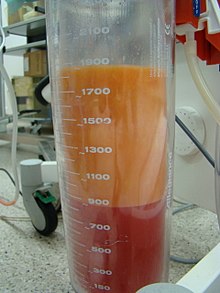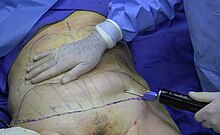Liposuction
This article needs additional citations for verification. (September 2017) |
| Liposuction | |
|---|---|
 A plastic surgeon performing liposuction surgery | |
| Other names | Lipoplasty, fat modeling, liposculpture, suction lipectomy, suction-assisted fat removal, lipo |
| ICD-9-CM | 86.83 |
| MedlinePlus | 002985 |
Liposuction, or simply lipo, is a type of cosmetic surgery that removes fat from the human body in an attempt to change its shape.[1] Evidence does not support an effect on weight beyond a couple of months and it does not appear to affect obesity related problems.[2][3] In the United States it is the most commonly done cosmetic surgery.[4][5]
Serious complications include deep vein thrombosis, organ perforation, bleeding, and infection.[6] Death occurs in about one per ten thousand cases.[7]
The procedure may be performed under general, regional, or local anesthesia. It then involves using a cannula and negative pressure to suck out fat.[4] It is believed to work best on people with a normal weight and good skin elasticity.[4]
While the suctioned fat cells are permanently gone, after a few months overall body fat generally returned to the same level as before treatment.[2] This is despite maintaining the previous diet and exercise regimen. While the fat returned somewhat to the treated area, most of the increased fat occurred in the abdominal area. Visceral fat - the fat surrounding the internal organs - increased, and this condition has been linked to life-shortening diseases such as diabetes, stroke, and heart attack.[2]
Uses
Liposuction is generally used in an attempt to change the body's shape.[1] Weight loss from liposuction appears to be of a short term nature with little long term effect.[2] After a few months fat typically returns and redistributes.[2] Liposuction does not help obesity related metabolic disorders like insulin resistance.[3]
Risks
There is a spectrum of complications that may occur due to any liposuction -- risk is increased when treated areas cover a greater percentage of the body, incisions are numerous, a large amount of tissue is removed, and concurrent surgeries are done at the same time.
Some side effects and complications include but are not limited to the following:
- Death
- Pain, which may be temporary or chronic
- Post-liposuction fat redistribution or post liposuction weight gain, [8]
- Limited mobility
- Bruising
- Infections can become serious issues.
- Embolisms may occur when loosened fat enters the blood through blood vessels ruptured during liposuction. Pieces of fat can wind up in the lungs, or even the brain. Fat emboli may cause permanent disability or, in some cases, be fatal.
- Puncture wounds in the organs (visceral perforations) may require surgery for repair. They can also prove fatal.
- Seroma is a pooling of serum, the straw-colored liquid from your blood, in areas where tissue has been removed.
- Paresthesias (changes in sensation that may be caused by nerve compression) is an altered sensation at the site of the liposuction. This may either be in the form of an increased sensitivity (pain), or numbness in the area. In some cases, these changes in sensation may be permanent.
- Swelling, in some cases, may persist for weeks or months after liposuction.
- Skin necrosis occurs when the skin above the liposuction site changes color and falls off. Large areas of skin necrosis may become infected with bacteria or microorganisms.
- Burns can occur during ultrasound-assisted liposuction if the ultrasound probe becomes hot.
- Fluid imbalance may impact you after you go home. The condition can result in serious ailments such as heart problems, excess fluid collecting in the lungs, or kidney problems.
- Toxicity from anesthesia due to the use of lidocaine, a skin-numbing drug, can cause lightheadedness, restlessness, drowsiness, a ringing in the ears, slurred speech, a metallic taste in the mouth, numbness of the lips and tongue, shivering, muscle twitching and convulsions. Lidocaine toxicity may cause the heart to stop.
- Scars at the site of the incision are usually small and fade with time, although some may be larger or more prominent.
- Deformities, Bumpy or wavy appearances or more severe deformities may occur at the liposuction site after the procedure.
Candidacy
One might question who is a good candidate for increased visceral fat, which the procedure causes.[9]
Techniques

In general, fat is removed via a cannula (a hollow tube) and aspirator (a suction device). Liposuction techniques can be categorized by the amount of fluid injection and by the mechanism in which the cannula works.
The marketing that goes on makes it hard for the consumer to determine truth from exaggeration.
Ultrasound-assisted liposuction techniques used in the 1980s and 1990s were associated with cases of tissue damage, usually from excessive exposure to ultrasound energy.[10] Third-generation UAL devices address this problem by using pulsed energy delivery and a specialized probe that allows physicians to safely remove excess fat.[11] Surgeons found that in some cases, the UAL method caused skin necrosis (death) and seromas, which are pockets of a pale yellowish fluid from the body, analogous to hematomas (pockets of red blood cells).[citation needed]

Sutures
Doctors disagree on the issues of scarring with not suturing versus resolution of the swelling allowed by leaving the wounds open to drain fluid. Since the incisions are small, and the amount of fluid that must drain out is large, some surgeons opt to leave the incisions open, while others suture them only partially, leaving space for the fluid to drain out.[12]
Usage
Removal of very large volumes of fat is a complex and potentially life-threatening procedure. The definition of "large volume liposuction" varies in the plastic surgery literature, no strict definition exists, and the term is arbitrary; every body is unique, so there is no "One Size Fits All" definition.
History
Relatively modern techniques for body contouring and removal of fat were first performed by a French surgeon, Charles Dujarier. A 1926 case that resulted in gangrene in the leg of a French model in a procedure performed by Dr. Dujarier set back interest in body contouring for decades.[13]
Liposuction evolved from work in the late 1960s from surgeons in Europe using primitive curettage techniques which were largely ignored, as they achieved irregular results with significant morbidity and bleeding [citation needed]. The invention of modern liposuction procedure is linked to the name of two Italian gynecologists, Arpad and Giorgio Fischer, who created the blunt tunneling[14] method in 1974. Then, liposuction first burst on the scene in a presentation by the French surgeon, Dr Yves-Gerard Illouz, in 1982.[citation needed]
Another French surgeon, Pierre Fournier[citation needed] used lidocaine as local anesthetic, modified the incision technique, and began to use compression after the operation. During the 1980s, many United States surgeons experimented with liposuction, developing some variation sedation rather than general anesthesia. Concerns over the high volume of fluid and potential toxicity of lidocaine with tumescent techniques eventually led to the concept of lower volume "super wet" tumescence.
Practitioners often report that many of the modern technologies touted to improve liposuction are simply advertising hooks.
See also
- Abdominal etching
- Bariatrics – branch of medicine that deals with the causes, prevention, and treatment of obesity
- Gastric bypass surgery
- Lipotomy
- Spot reduction
Notes
- ^ a b Dixit, VV; Wagh, MS (May 2013). "Unfavourable outcomes of liposuction and their management". Indian Journal of Plastic Surgery. 46 (2): 377–92. doi:10.4103/0970-0358.118617. PMC 3901919. PMID 24501474.
{{cite journal}}: CS1 maint: unflagged free DOI (link) - ^ a b c d e Seretis, Konstantinos; Goulis, Dimitrios G; Koliakos, Georgios; Demiri, Efterpi (2015). "Short- and Long-Term Effects of Abdominal Lipectomy on Weight and Fat Mass in Females: A Systematic Review". Obesity Surgery. 25 (10): 1950–8. doi:10.1007/s11695-015-1797-1. PMID 26210190.
- ^ a b Seretis, K; Goulis, DG; Koliakos, G; Demiri, E (December 2015). "The effects of abdominal lipectomy in metabolic syndrome components and insulin sensitivity in females: A systematic review and meta-analysis". Metabolism: clinical and experimental. 64 (12): 1640–9. doi:10.1016/j.metabol.2015.09.015. PMID 26475176.
- ^ a b c Norton, Jeffrey A. (2012). Surgery Basic Science and Clinical Evidence. Berlin, Heidelberg: Springer Berlin Heidelberg. p. 2014. ISBN 9783642572821.
- ^ Khan, MH (November 2012). "Update on liposuction: clinical pearls". Cutis. 90 (5): 259–65. PMID 23270199.
- ^ Tierney, Emily P.; Kouba, David J.; Hanke, C. William (December 2011). "Safety of tumescent and laser-assisted liposuction: review of the literature". Journal of Drugs in Dermatology. 10 (12): 1363–9. PMID 22134559.
- ^ Draelos, Zoe (2011). Cosmetic Dermatology: Products and Procedures. John Wiley & Sons. p. Chapter 56. ISBN 9781444359510.
- ^ http://onlinelibrary.wiley.com/doi/10.1038/oby.2011.64/abstract;jsessionid=6981202861C14BC180A4C310328C3948.f04t02
- ^ Hernandez, Teri L; Kittelson, John M; Law, Christopher K; Ketch, Lawrence L; Stob, Nicole R; Lindstrom, Rachel C; Scherzinger, Ann; Stamm, Elizabeth R; Eckel, Robert H (2011). "Fat Redistribution Following Suction Lipectomy: Defense of Body Fat and Patterns of Restoration". Obesity. 19 (7): 1388. doi:10.1038/oby.2011.64. PMID 21475140.
- ^ Jewell, M (2008). "Innovation in Plastic and Aesthetic Surgery Lipoplasty". Innovations in Plastic and Aesthetic Surgery. pp. 443–53. doi:10.1007/978-3-540-46326-9_55. ISBN 978-3-540-46321-4.
- ^ De Souza Pinto, Ewaldo Bolivar; Chiarello De Souza Pinto Abdala, Priscila; Montecinos Maciel, Christovam; De Paula Turchiari Dos Santos, Fabiana; Pessoa Martello De Souza, Rodrigo (2006). "Liposuction and VASER". Clinics in Plastic Surgery. 33 (1): 107–15, vii. doi:10.1016/j.cps.2005.09.001. PMID 16427979.
- ^ MedlinePlus Medical Encyclopedia: Liposuction
- ^ Glicenstein, J (1989). "L'affaire Dujarier" [Dujarier's case]. Annales de Chirurgie Plastique Esthétique (in French). 34 (3): 290–2. PMID 2473691.
- ^ "Coleman III, William. P.: The History of Liposculpture". Retrieved 2013-08-25.
